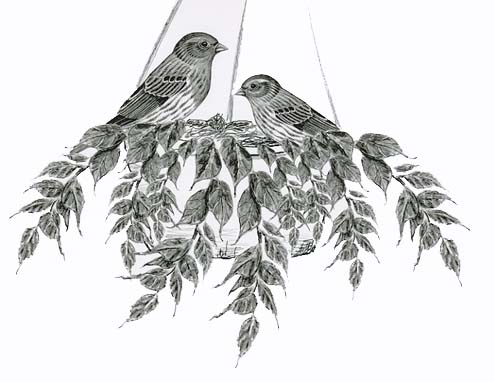
Dear Bird Folks:
For three years in a row Purple Finches have nested in the alcove between our house and garage. We have a shelf over the door going into the garage with four pretty bird houses on it. In the past two years the finches have built their nest on the shelf between two of the houses. This year they have built in the old Christmas wreath. Do Purple Finches normally nest so close to human activity?
-Roland, Chatham
You’ll Understand Roland,
Because you are from Chatham. You know, when some guy from off Cape pronounces the name of your town “Chat-ham” instead of “Chat-em”? You have to decide whether to say “Dude, it is totally not pronounced Chat-ham”. Or do you let it go and leave the correcting job to someone else? Well, I’m the correcting guy and my job is to point out that your “Purple Finches” are really “House Finches”. Whether you live in Chat-ham or Chat-em, or East-ham or East-em those cute little birds nesting in your alcove are House Finches.
How do I know for sure your birds are House Finches? Because as their first name “House” suggests, these birds like to live around our homes. So, to answer your question, no, Purple Finches do not normally nest near human activity. Purple Finches like to nest alone, high up in conifers. They aren’t squatters like the House Finches, who love to live near us.
Purple Finches are handsome songbirds that, unfortunately for us, are rare on Cape Cod. Conversely, the House Finch population is huge. They are everywhere. They are nearly as common as SUVs are at a gas station. And believe it or not, House Finches are new to this area. They were introduced about sixty years ago and their population has exploded during the past few decades. While at the same time, the Purple Finch population has declined.
The knee-jerk reaction is that the newer aggressive House Finch must be causing the decline of the Purple finch. That maybe true, no one really knows for sure. But the Purple Finch population decline began long before House Finches arrived in this area, so their drop-off is most likely tied to changes in habitat, rather than the arrival of another species.
The reason why many people mistakenly call the very common House Finch, “Purple Finch” can be blamed on the old bird books. Since the House Finch is new around here, really old field guides don’t even have them pictured. The other problem is that the two species look very similar and could easily be confused with each other.
How do you tell them apart you ask?? Well, around here it’s easy. Since Purple Finches are rare on the Cape, if you see more than one it will be a House Finch. And just on the odd chance that you travel off Cape some day, I’ll give you some visual clues on distinguishing the two birds as well.
First of all, neither bird is purple or looks like a house. The male House Finch has bright red on the head, chest and base of the tail, the rest of the bird is sparrow brown. The male Purple Finch is a deeper red and the deep red is washed over most of the bird, including its back. The back is always brown on a House Finch. Both birds have white on the belly, near the legs, but the House Finch also has brown streaking on the belly, while once again, the Purple Finch has red streaking. The females have no red at all. The Purple Finch is mostly brown with a bold stripe above the eye, while the female House Finch is basically streaky brown with nothing else worth talking about.
We mentioned earlier that House Finches love to build in or around our buildings. Just as you found out Roland, they’ll build in old Christmas wreathes or on porch lights. Their all time favorite nesting site seems to be in hanging plants. All day long I listen to people who are complaining about finches nesting in their hanging plants. They want to buy a $20.00 bird house, to keep the finches from nesting in their $5.00 hanging plant. What? Hello, McFly, just go buy a new plant and save yourself fifteen bucks.
I’m glad you are enjoying your nesting birds Roland. And don’t worry that you still have a Christmas wreath up in June, I’m still trying to get rid of a fruit cake.